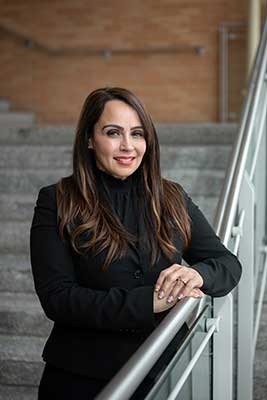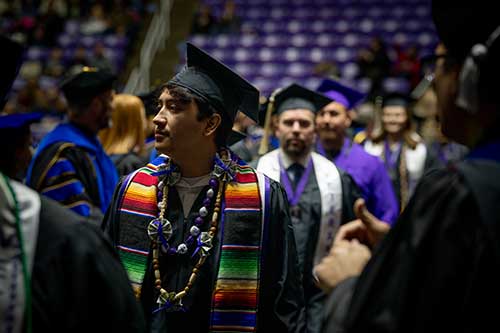
A Focus on Service
Among the many acronyms Weber State faculty and staff use every day, eHSI has become increasingly prevalent in conversations about the university’s future.
It connects with the strategic plan, Weber State Amplified, a 5-year plan for growth, which commits to increasing the percentage of students who identify as Hispanic or Latino to 15% BY 2025. Reaching this goal would make WSU an eHSI (emerging Hispanic-Serving Institution).
As of fall 2022, Hispanic and Latino students made up 12.5% of full-time equivalent undergraduates. WSU plans to attract and retain more students by increasing services and support.
Becoming an eHSI, however, isn’t about placing one group over another.
It’s about helping WSU better reflect its surrounding community, creating a service model that can be adapted for all students and improving the local economy.
Utah’s K–12 public education system is about 20% Hispanic or Latino, and over 50% of Ogden School District’s students represent the demographic. Making sure more of these students feel welcome at Weber State will mean more youth from local schools go to college, gain in-demand skills employers are looking for and achieve greater economic outcomes.
 Yudi Lewis, Hispanic-Serving Initiatives executive director, said the most important part of eHSI is the “S,” since it will lead to improved services across the board.
Yudi Lewis, Hispanic-Serving Initiatives executive director, said the most important part of eHSI is the “S,” since it will lead to improved services across the board.
“In trying to streamline access and support services for one segment of our student population, we are, in turn, creating streamlined access and support services for all segments of our student population,” she said. “We are including everyone.”
Examining eHSI
To understand eHSI, you must first understand HSI (Hispanic-Serving Institution).
An HSI designation is outlined by Congress in the Higher Education Act as a higher-learning institution with a full-time equivalent undergraduate student body that is at least 25% Hispanic, according to the Hispanic Association of Colleges and Universities.
Once institutions obtain that status, they’re eligible for additional federal funding.
In 2020–21, there were 559 HSIs in 29 states, Washington, D.C. and Puerto Rico, but none in Utah, where the Hispanic and Latino population is the fastest-growing demographic group.
While there is no federal definition for eHSI, Excelencia in Education, a nonprofit organization supporting Latino student achievement, identifies an eHSI as an institution with an undergraduate Hispanic enrollment between 15% and 24%.
Weber State officially adopted its eHSI goal in its strategic plan in spring 2021.
“While other colleges and universities in Utah are now working to achieve HSI status, nobody was willing to be the brave one to make the first public statement; we were the first,” said Adrienne Andrews, vice president for Equity, Diversity and Inclusion and chief diversity officer. “The rest of the institutions in the state have followed our lead.”
The declaration resulted in a $500,000 grant from Ally Financial Inc.
“Our support of Weber State is part of our organization’s deep commitment to creating pathways to economic mobility in diverse communities,” said Jan Bergeson, Ally Bank executive director and Community Reinvestment Act officer.
Weber State used the funds to create Lewis’s position, identify gaps in student recruitment and retention, and coordinate resources for underserved students.
Lewis said she is now collaborating with university departments, other Utah institutions and partners in the community to help serve students.
“We’re not just preparing students to take college classes, we’re helping Hispanics and Latinos transition from high school to a certificate or college degree and then to a career they’re passionate about,” she said. “We are transforming generations, one student at a time.”
 Student Support from Different Perspectives
Student Support from Different Perspectives
Weber State’s goal is not without its detractors.
Lewis and Andrews acknowledge that public discussions about diversity and inclusion can trigger criticism and pushback leading to misconceptions.
“But we need to go beyond the negative comments and be mindful that we’re trying to create a space in educational settings for individuals who have not often had that space,” Lewis said.
A low number of Hispanic and Latino students participating in concurrent enrollment programs, which offer high school students classes where they earn college credit, is one reason Lewis said many do not go on to college.
“Concurrent enrollment students engage in college courses early on in their life. These students are likely to be motivated to make that transition from high school to college,” she said.
According to the Utah State Board of Education (USBE) and the Utah System of Higher Education, 83.9% of students in concurrent enrollment courses were Caucasian while only 9.9% were Hispanic and Latino during the 2020–2021 academic year, despite making up about 18% of 2021 high school graduates based on a USBE report.
Andrews emphasizes that becoming an eHSI signals a desire to anticipate demographic shifts and a willingness to amend a higher educational system to support more students.
It is not about taking something from one group and giving it to a different group.
“There are some students who do just fine with the system as it exists,” she said. “We don’t need to change anything for them in terms of how they’re receiving support; but for the students who were not having success at Weber because the system wasn’t created for them, there must be a structure and a framework put in place that recognizes an unintentional bias and closes systemic gaps in student support and services.”
 Forecasting Positive Outcomes
Forecasting Positive Outcomes
The following is not an exhaustive list of what Weber State hopes to achieve by reaching eHSI status, but rather a bird’s-eye view of anticipated outcomes from a campus-wide effort the university hopes students and employees will embrace and support.
1. It will advance WSU’s dual mission.
As assigned by the Utah Legislature and Utah Board of Higher Education, Weber State serves a dual mission, providing every academic amenity associated with a four-year university in addition to the two-year programs and certifications offered at a community college. As an open-enrollment institution, WSU allows all students an opportunity to pursue and complete a college degree or certificate.
“Our goal is to be able to meet all our students where they are and give them the challenges and tools they need to be successful,” Andrews said.
She maintains that identity impactors, such as ethnicity, gender or income, are emphasized in current discussions only because they have proven to be so consequential to student success.
“Once we’re aware that there’s an obstacle to somebody’s learning, then we can find a way to minimize it,” she said. “Our goal is to set up a successful proposition for any student who wants to take advantage of it, and, if we fail to do that, we fail to fulfill the mission of our legislative charter.”
2. It will boost enrollment and retention.
At a time when U.S. college enrollments are declining, Weber State’s goal is to enroll 32,000 students by the 2025–26 academic year.
However, demographers are predicting fewer high school graduates starting in 2025. They warn that unless colleges and universities bring in and retain more students, they will struggle to remain viable. Education analysts say colleges need fresh strategies to attract populations they have previously underserved: high school students taking college courses, community college transfers and working adults. These same experts say new students will show up when they see campuses committed to delivering what they want and need.
While enrolling students is part of the plan, Lewis added that supporting students to complete their degrees is equally important. “What we want at Weber State is for every student who walks through our doors to know that they belong in our institution, and we are willing to do everything possible to create a welcoming and supportive space for everybody,” she said.
3. It will add to the value of a WSU education.
Part of what Weber State hopes to achieve by pursuing eHSI status is to ensure a stimulating mix of intellectual, cultural and educational perspectives on its campuses.
Research shows that students who explore culturally diverse views and interact with people from different backgrounds become more creative thinkers, better problem solvers and more accepting members of society.
“We need to stay away from that deficit mentality that students from historically underserved backgrounds are not college material,” Lewis said. “These students have dreams and aspirations. Weber State offers educational opportunities and support services to enable all students to complete a college education.”
Andrews adds that the effort is also driven by a desire to prepare a job-market-ready workforce for a global economy. “Students can learn all that in team-building experiences where they have to work on some kind of classroom project with people who are like them and people who are not like them, and that’s important because the ability to work collaboratively and think critically are the kinds of skills that employers seek,” she said.
4. It will help WSU serve its community.
Weber State’s Ogden campus is located in Weber County, home to the second highest concentrations of Hispanic and Black populations in Utah. However, the composition of WSU’s student population doesn’t reflect the community’s diversity.
Ogden High School, which has a nearly 50% Hispanic and Latino student population, boasted 393 graduates in 2022, but only 75 came to Weber State. Of those 75 students, 25 identified as Hispanic or Latino. Lewis finds the statistic alarming. “Where are the rest of those graduates? Why aren’t they at Weber State? Did they even go to college?” Lewis asked.
“As we figure out the pieces that will be meaningful for this particular Hispanic demographic of students — to not only enroll at Weber State, but to remain and persist until they graduate — we’ll create a model that will benefit other marginalized populations as well,” Andrews said. “If we don’t make this shift, we are holding back the earning potential of our own communities and the citizenry of the nation.”
Ogden School District 2022–23 Hispanic and Latino headcount enrollment
| School | Hispanic student % |
| Ben Lomond High School | 59.98% |
| George Washington High School | 52.30% |
| Ogden High School | 47.17% |
| Highland Junior High School | 61.92% |
| Mound Fort Junior High School | 51.04% |
| Mount Ogden Junior High School | 39.74% |
| Weber State University | 11.8% |
Source: Utah State Board of Education and Utah System of Higher Education
5. It will increase Utah’s economic prosperity.
Higher education constitutes one of the most significant influences on the state’s economy, consistently producing the labor supply that powers economic momentum.
An estimated 439,000 people of Hispanic or Latino descent live in Utah — the actual number could be higher. According to the Utah State Board of Education, 131,954 Hispanic and Latino students are in Utah’s K–12 public education system.
Informed by forecasts of Utah’s economic and workforce needs, the Utah System of Higher Education calls for the following:
- More Utah high school graduates enrolling and graduating from USHE institutions
- More students completing college degrees in a timely manner
- More students earning college degrees that align with high-wage, high-demand occupations
A 2021 Economic Report to the Governor, prepared by the Utah Economic Council, anticipates the percentage of people of color ages 18–35 in Utah will nearly double by 2065.
The report notes the need for significant changes to address a degree attainment gap within the USHE system. “Multi-dimensional strategies will be used to increase the system’s positive contribution to workforce development with a specific focus on closing equity gaps that inhibit the full realization of our state’s workforce and economic potential,” the report stated.

Yuritzi Rosas Hernandez majors in marketing and economics. She serves on the WSUSA Diversity and Unity team and was recently elected 2023–24 vice president of community engagement. As a student leader, she supports WSU’s goal to make college more accessible to Hispanic and Latino students.
Moving Forward
Weber State President Brad Mortensen recently announced the university’s efforts have been working. “We have legitimately made progress towards our 15% goal as our Latino and Hispanic student enrollment percentage has increased by about half of a percentage point in fall 2021 and, again, in fall 2022,” he said. “But I think the real progress has been in the culture of Weber State faculty, staff and students embracing the goal and working collaboratively to achieve such a significant milestone.”
